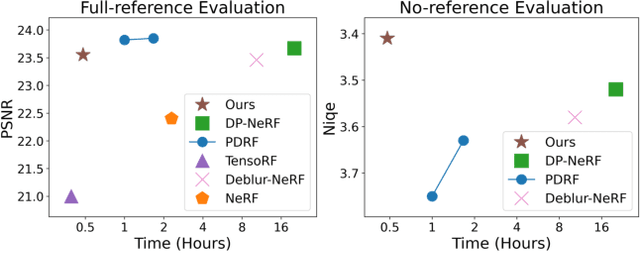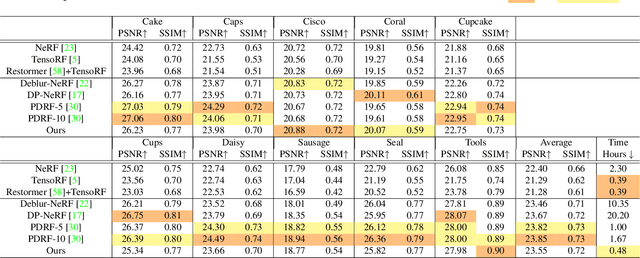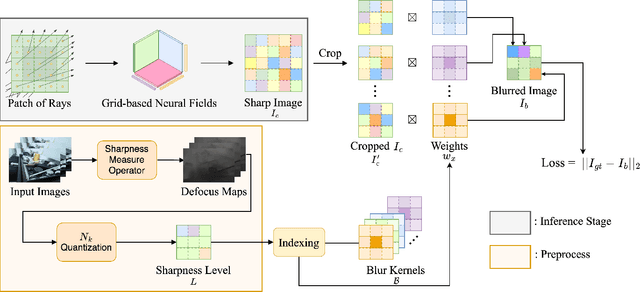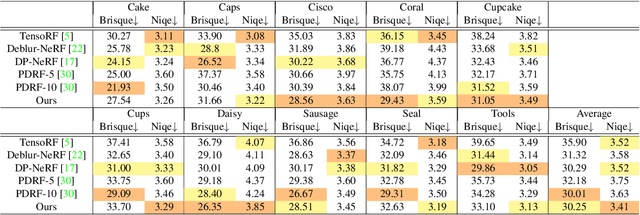Howoong Lee
Sharp-NeRF: Grid-based Fast Deblurring Neural Radiance Fields Using Sharpness Prior
Jan 01, 2024



Abstract:Neural Radiance Fields (NeRF) have shown remarkable performance in neural rendering-based novel view synthesis. However, NeRF suffers from severe visual quality degradation when the input images have been captured under imperfect conditions, such as poor illumination, defocus blurring, and lens aberrations. Especially, defocus blur is quite common in the images when they are normally captured using cameras. Although few recent studies have proposed to render sharp images of considerably high-quality, yet they still face many key challenges. In particular, those methods have employed a Multi-Layer Perceptron (MLP) based NeRF, which requires tremendous computational time. To overcome these shortcomings, this paper proposes a novel technique Sharp-NeRF -- a grid-based NeRF that renders clean and sharp images from the input blurry images within half an hour of training. To do so, we used several grid-based kernels to accurately model the sharpness/blurriness of the scene. The sharpness level of the pixels is computed to learn the spatially varying blur kernels. We have conducted experiments on the benchmarks consisting of blurry images and have evaluated full-reference and non-reference metrics. The qualitative and quantitative results have revealed that our approach renders the sharp novel views with vivid colors and fine details, and it has considerably faster training time than the previous works. Our project page is available at https://benhenryl.github.io/SharpNeRF/
Deblurring 3D Gaussian Splatting
Jan 01, 2024Abstract:Recent studies in Radiance Fields have paved the robust way for novel view synthesis with their photorealistic rendering quality. Nevertheless, they usually employ neural networks and volumetric rendering, which are costly to train and impede their broad use in various real-time applications due to the lengthy rendering time. Lately 3D Gaussians splatting-based approach has been proposed to model the 3D scene, and it achieves remarkable visual quality while rendering the images in real-time. However, it suffers from severe degradation in the rendering quality if the training images are blurry. Blurriness commonly occurs due to the lens defocusing, object motion, and camera shake, and it inevitably intervenes in clean image acquisition. Several previous studies have attempted to render clean and sharp images from blurry input images using neural fields. The majority of those works, however, are designed only for volumetric rendering-based neural radiance fields and are not straightforwardly applicable to rasterization-based 3D Gaussian splatting methods. Thus, we propose a novel real-time deblurring framework, deblurring 3D Gaussian Splatting, using a small Multi-Layer Perceptron (MLP) that manipulates the covariance of each 3D Gaussian to model the scene blurriness. While deblurring 3D Gaussian Splatting can still enjoy real-time rendering, it can reconstruct fine and sharp details from blurry images. A variety of experiments have been conducted on the benchmark, and the results have revealed the effectiveness of our approach for deblurring. Qualitative results are available at https://benhenryl.github.io/Deblurring-3D-Gaussian-Splatting/
 Add to Chrome
Add to Chrome Add to Firefox
Add to Firefox Add to Edge
Add to Edge